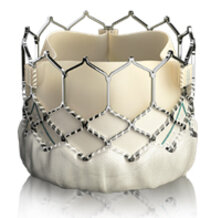Catheter-based aortic valve implantation (TAVI)

© Edwards Sapien 3 transcatheter valve
Degenerative narrowing of the aortic valve (aortic valve stenosis) is the most common heart valve disease. It is accompanied by symptoms such as heart pain and shortness of breath. If left untreated, it leads to death in 75 percent of patients in the first three years after the onset of symptoms.
In catheter-based aortic valve implantation, a bioprosthesis anchored on a metal mesh (Figure 5) is implanted via the inguinal artery or via the apex of the heart under fluoroscopic guidance (Movie 1, @Edwards).